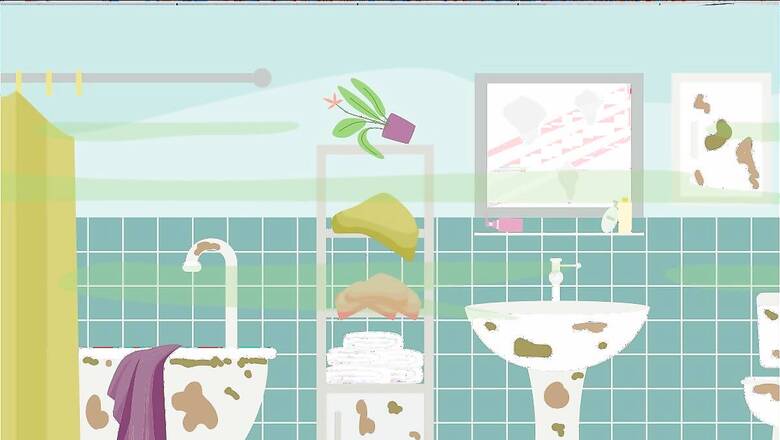
views
If you live in an Indian city, particularly a coastal one, then you’ve seen urban flooding first-hand: cars sloshing through roads with standing water, nowhere for pedestrians to walk, and slush and refuse everywhere. These incidents are invariably followed by a string of disease outbreaks – particularly diarrhoeal disease. The reason this happens is because faecal matter contaminates our streets, footpaths, water supplies and we carry these pathogens into our homes in our soaked shoes, socks, clothing and umbrellas.
When a city (or even a small city block) floods, all the public toilets situated in it flood too, creating a public health crisis. With climate change pushing us into an era of monsoons that are increasingly erratic and much stronger than before, the need of the hour is monsoon-proof infrastructure. Specifically, we need monsoon-proof toilets.
Monsoon-proof toilets are a type of eco-friendly toilets that are designed to withstand heavy rainfall and prevent flooding and waterlogging. They are especially useful in regions like ours, where monsoon seasons bring frequent and intense rain. However, waste management in monsoon-proof toilets poses significant environmental challenges that need to be addressed.
Environmental Concerns in Waste Management of Monsoon-Proof Toilets
One of the main challenges in waste management of monsoon-proof toilets is the impact of heavy rainfall on the sewage systems. During the monsoon season, the excess water can cause the sewage systems to overflow and flood, resulting in the release of untreated waste into the environment. This can contaminate the water bodies and soil, posing serious health and environmental risks. Some of the potential risks and consequences are:
Spread of waterborne diseases:
If untreated waste enters into water sources it can increase the risk of waterborne diseases, such as diarrhoea, cholera, typhoid, and dysentery. These diseases can affect millions of people, especially children and the elderly, and those who lack access to safe drinking water and clean and safe toilets.
Soil pollution and degradation:
The spread of untreated waste into the soil can affect its quality and fertility, making it unsuitable for agriculture and other uses. Soil pollution can also affect the groundwater quality and availability, as well as the soil biodiversity and ecosystem services.
Adverse impacts on aquatic ecosystems and biodiversity:
The discharge of untreated waste into water bodies can affect aquatic life and biodiversity, causing eutrophication (when you have too many nutrients in the water, causing certain organisms to flourish at the cost of others), algal blooms, oxygen depletion, fish kills, and habitat loss.
Effective Solutions for Waste Disposal in Monsoon-Proof Toilets
To address the environmental concerns in waste management of monsoon-proof toilets, there are some effective solutions that can be implemented at different levels:
Design and Infrastructure Considerations:
One of the key aspects of waste management in monsoon-proof toilets is to ensure that they have proper drainage systems to handle excess rainfall and prevent overflowing and flooding, as well as reduce the risk of waterlogging and clogging. Additionally, installing septic tanks or biodigesters can help contain and treat the waste before it is discharged into the environment. Septic tanks or biodigesters are underground chambers that store and decompose the waste anaerobically (without oxygen), producing biogas and sludge. The biogas can be used as a source of energy, while the sludge can be used as a fertiliser.
Waste Treatment Technologies:
Another important aspect of waste management in monsoon-proof toilets is to adopt appropriate waste treatment technologies that can reduce the environmental impact of waste disposal. Two examples of such technologies are anaerobic digestion and composting. Anaerobic digestion converts organic waste into biogas and fertiliser through microbial action in an oxygen-free environment. It can reduce greenhouse gas emissions, odours, pathogens, and organic matter in the waste. Composting is a process that transforms organic waste into nutrient-rich soil amendment through aerobic decomposition by microorganisms. Composting can improve soil quality, reduce landfill waste, and lower greenhouse gas emissions.
Encouraging Behaviour Change:
A third aspect of waste management in monsoon-proof toilets is to encourage behaviour change among the users and communities. This involves promoting responsible waste disposal practices, such as using toilet paper instead of water for cleaning, separating solid and liquid waste, disposing of sanitary products properly, and avoiding flushing non-biodegradable items. Moreover, raising awareness about the importance of proper waste management and its benefits for health and environment can motivate people to adopt eco-friendly toilets and maintain them regularly. Educating communities on how to use and operate monsoon-proof toilets and their waste treatment systems can also help ensure their efficiency and sustainability.
Building Education and Awareness In Our Communities
For any solution to take hold, it requires the right momentum behind it. As the Swachh Bharat Mission’s own Sub-Group of Chief Ministers found, it isn’t enough to just build the toilets, but to also help anchor the new behaviours. The best way to do so is to educate not just the users, but all stakeholders involved – from policymakers and elected officials, to local municipalities, to local and national environmental groups, and the sanitation workers involved.
Harpic understands this. Since 2016, Harpic World Toilet Colleges have worked to both uplift sanitation workers and to ensure they receive the right training to keep our communities and environments safe. Not only has the brand worked tirelessly to build a strong communication strategy around the need for good toilet hygiene habits in particular, it has also developed thought provoking campaigns and outreach programs.
Harpic partnered with Sesame Workshop India, an educational non-profit working for the early developmental needs of young children, to promote positive sanitation, hygiene knowledge and behaviours among children and families through schools and communities, engaging with 17.5 million children across India. It also pioneered a programme to raise awareness and reinforce healthy toilet and bathroom habits among young children, developing and recognising them as “Swachhta Champions”. These initiatives are a part of the larger umbrella campaign, Harpic Mission Swachhta aur Paani, with News18.
Mission Swachhta aur Paani is a movement that upholds the cause of inclusive sanitation where everyone has access to clean toilets. It advocates equality for all genders, abilities, castes and classes and strongly believes that clean toilets are a shared responsibility. It is a valuable platform for bringing together policymakers, NGOs, activists and several other stakeholders to build consensus in thought and action. It also serves as a repository of information that helps you have the right conversations with the right parties.
Join us here, to learn how you can contribute to this national conversation, and pave the way to a Swasth Bharat, and a Swachh Bharat.



















Comments
0 comment